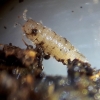Geology Site Account
A-Z Geological Site Index
UfdG11, Clatterbury Lane Puddingstone, ARKESDEN, Uttlesford District, TL48343422, Notified Local Geological Site
|
Site category: Boulders - puddingstone Site name: Clatterbury Lane Puddingstone, Arkesden Grid reference: TL 4834 3422 Brief description of site: On the side of Clatterbury Lane to the south of the village of Arkesden is a very large and colourful boulder of Hertfordshire puddingstone. The stone is about 2 metres long and is accessible at all times, although it is almost completely obscured by vegetation on the grass verge by the roadside. ---------------------------------------- Details Hertfordshire Puddingstone was formed around 55 million years ago when the climate of Britain was hot and a layer of pebbles beneath the surface of the ground became cemented with quartz. They are thus very resistant to erosion and have survived the rigours of the Ice Age. They originated in Hertfordshire, hence the name, and were probably carried to Essex by the River Thames when it flowed north of its present course. However, the distribution and abundance of Hertfordshire puddingstone in Arkesden suggests that there may have been a local source not far from here. The formation of silcretes (which includes sarsens and puddingstones) has been the subject of recent scientific debate. Research has compared the conditions under which sarsens and puddingstones may have been formed with the present day climate in the Kalahari Desert and parts of Australia. Arkesden is unique in Essex for the number of boulders that are scattered around the village. They can also be seen in the churchyard, in the stream bed, by the inn, and in private gardens. The stone is 2 metres by 1.3 metres by 1 metre in size. A.E. Salter, in his 1914 paper, mentions this large puddingstone as being at the side of the road to Wood Hall. Wood Hall is south of the village and there is no doubt that he is referring to this stone. There is no information about why this particular stone was placed in this position. Erratic boulders link geology and social history. This boulder was apparently brought here from somewhere on the Wood Hall estate, probably less than a mile to the south, and transported by horse-drawn sledge (Green 2014).
|
if you have an image please upload it
|
Reference: Salter 1914, Lucy 2003a, Lucy 2014, Green 2014.
Notified: July 2024
Geology Site Map
A-Z Geological Site Index
























